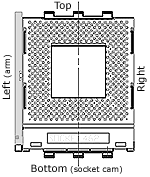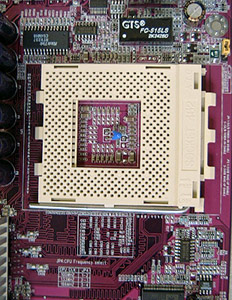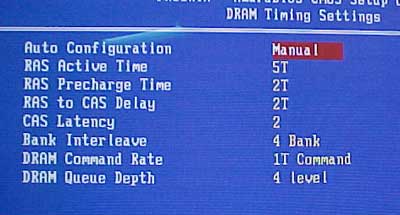| pcstats
heatsink clearance measurements |
| top clearance: |
12 mm |
| bottom (cam) clearance: |
10 mm |
|
| left side (arm) clearance: |
33 mm |
| right side clearance |
16 mm |
|
| socket mounting holes: |
n/a |
| max. heatsink base dimensions: |
~83x82 mm |
|
 Note: Approx.
measurements are made from the edge of the socket (not the clips) to
the closest obstacle taller than the ZIF socket
itself. Note: Approx.
measurements are made from the edge of the socket (not the clips) to
the closest obstacle taller than the ZIF socket
itself.
The socket is 51mm across, and 62mm from
top to bottom. | |
 |
Magic-Pro did a decent job
of clearing the area next to the CPU socket of obstructions. Larger heatsinks
like the Thermalright SLK-800 or Vantec Aeroflow should fit on this board well.
Because there are no mounting holes around the socket, older larger heatsinks
like the Swiftech MCX 462 or Alpha PAL8045 are obsolete.
Overclocking the Purple
Monster:
Hey, just because this board is a budget mobo doesn't mean
we're going to spare it from our overclocking tests!
Using an AthlonXP
3000+ processor we started lowering the multiplier to 10x, and raised the FSB up a
notch. Unfortunately, our overclocking adventures were cut short and we ended
up maxing out at a lowly 178 MHz FSB.
With no AGP/PCI locking, I believe the ATi Radeon 9700 Pro
was holding back the motherboard. Perhaps someone
with a Ti4600 or older videocard could have pushed the board a bit
farther, but with out a DX9 videocard what fun would that be?
Exploring the Blue
BIOS:

People with VIA based motherboards
should recognize that screen shot. Here we have all the usual memory tweaks that
one would expect.

There are a whole slew of AGP options
for the hardcore tweaker.

If you have an unlocked processor Magic-Pro gives you access
to the 5-12.5x range. Maximum FSB on the motherboard is 233 MHz and
it's adjustable in 1 MHz increments. VDIMM goes up to 2.8V, AGP to 1.6V and VCC
to 2.6V. Up next, the benchmarks.
